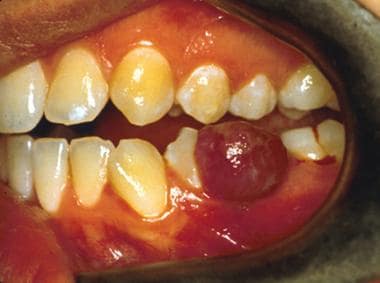Background
The pyogenic granuloma is a relatively common, tumorlike, exuberant tissue response to localized irritation or trauma. The name pyogenic granuloma is a misnomer since the condition is not associated with pus and does not represent a granuloma histologically. It is a reactive inflammatory process filled with proliferating vascular channels, immature fibroblastic connective tissue, and scattered inflammatory cells. The surface usually is ulcerated, and the lesion exhibits a lobular architecture. Note the image below.
 Typical appearance of a pyogenic granuloma involving the buccal gingiva of teeth numbers 20 and 21. Note the extreme vascularity.
Typical appearance of a pyogenic granuloma involving the buccal gingiva of teeth numbers 20 and 21. Note the extreme vascularity.
Two lesions, peripheral ossifying fibroma and peripheral giant cell granuloma, are clinically identical to the pyogenic granuloma when they occur on the gingiva. If 100 biopsies of pyogenic granuloma–appearing lesions of the gingiva are submitted for histologic examination, approximately 75% will be pyogenic granulomas, 20% will be peripheral ossifying fibromas, and 5% will be peripheral giant cell granulomas. The pyogenic granuloma can occur anywhere in the oral cavity, whereas the peripheral ossifying fibroma and peripheral giant cell granuloma only occur on the gingiva or alveolar mucosa. The clinical appearance, treatment, and prognosis are the same for all 3 entities.
Pathophysiology
The pyogenic granuloma most frequently develops on the buccal gingiva in the interproximal tissue between teeth. Three quarters of all oral pyogenic granulomas occur on the gingiva, with the lips, tongue (especially the dorsal surface), and buccal mucosa also affected. A history of trauma is common in extragingival sites, whereas most lesions of the gingiva are a response to irritation. Individuals with poor oral hygiene and chronic oral irritants (eg, overhanging restorations, calculus) most frequently are affected. Pregnancy exacerbates the tendency to develop a pyogenic granuloma.
Etiology
A history of trauma is common in extragingival sites, whereas most lesions of the gingiva are a response to irritation. [1] Individuals with poor oral hygiene and chronic oral irritants (eg, overhanging restorations, calculus) most frequently are affected.
In 2010, a case of pyogenic granuloma was reported around an implant. This will be a more common occurrence as the number of implants and associated peri-implantitis continues to increase. [2]
Epidemiology
Frequency
Lesions have a similar frequency throughout the world.
Race
No racial predilection is reported.
Sex
Females are far more susceptible than males because of the hormonal changes that occur in women during puberty, pregnancy, and menopause. The pyogenic granuloma has been called a "pregnancy tumor" and does occur in 1% of pregnant women. When possible, wait until after delivery to remove the lesion in pregnant women because of a greater tendency for recurrence during pregnancy.
In a number of cases, mastication on the lesion causes bleeding and pain and requires surgical intervention before parturition. Some pyogenic granulomas regress after childbirth without surgical intervention.
Age
Pyogenic granulomas occur at any age, but they most frequently affect young adults.
Prognosis
The prognosis is excellent, and the lesion usually does not recur unless inadequately removed. Lesions removed during pregnancy may have a higher recurrence rate. This is a benign reactive/inflammatory proliferation that does not recur after surgical removal. However, lesions of the gingiva need to have the potential irritants such as plaque and calculus removed to prevent a reoccurrence. Mastication on the lesion can cause bleeding and pain and can require surgical intervention before parturition in lesions associated with pregnancy. [3]
Patient Education
This is a benign reactive/inflammatory process that can be avoided (even in pregnancy) by using good oral hygiene and not allowing plaque and calculus to build up on the teeth. The pyogenic granulomas are most commonly found on the gingiva, but they can also be found on other oral locations. Pregnancy exacerbates the tendency to develop this lesion.
-
Typical appearance of a pyogenic granuloma involving the buccal gingiva of teeth numbers 20 and 21. Note the extreme vascularity.
-
Pyogenic granuloma of the anterior maxilla showing a small amount of involvement on the buccal gingiva of teeth numbers 8 and 9 with most of the lesion on the lingua. Note that indentations from the lower teeth are on the surface of the tumor.
-
Pyogenic granuloma of the dorsal tongue in a 52-year-old black woman. An area of geographic tongue is adjacent to the pyogenic granuloma.
-
Pyogenic granuloma associated with teeth numbers 20 and 21 in a 27-year-old white woman who is 8 months pregnant. The lesion was excised without curetting the area to remove irritants.
-
Same patient as in Image 4 with a lesion that recurred almost immediately. This picture was taken 1 month after the birth of her child.
-
Rapidly growing pyogenic granuloma in the area of teeth numbers 20 and 21 in a 13-year-old black girl. Notice the calculus and plaque on tooth number 22. The lesion was soft to palpation.
-
Pyogenic granuloma on the facial gingiva of teeth numbers 7 and 8. This is a long-standing lesion that is becoming fibrosed and less vascular. Notice the pink coloration at the base of the lesion.





